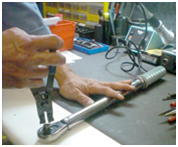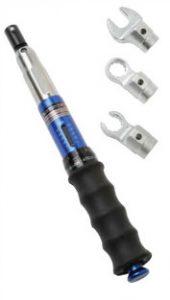Preventive Maintenance for a Torque Wrench
 To maintain consistent accuracy, torque wrenches must be checked periodically for wear or defective parts. A properly structured preventive maintenance program optimizes tool performance and reduces unexpected downtime, thereby saving time and money.
To maintain consistent accuracy, torque wrenches must be checked periodically for wear or defective parts. A properly structured preventive maintenance program optimizes tool performance and reduces unexpected downtime, thereby saving time and money.
The more often a torque wrench is used the faster it will wear or go out of calibration. Monitoring the number of cycles per day or total hours that a tool is used is the most accurate way to establish proper maintenance intervals. It is accepted that torque wrenches should be serviced in line with manufacturers recommendations or no longer than 100,000 cycles, or when a visual inspection reveals old or dry grease, parts that show signs of excessive wear, loose or unstable components.
 The ratchet of a wrench should be inspected for wear, cleaned and lubricated. Periodically verify that ratchet screws are tight and that the ratchet spins freely when turned. The wrench handle should not be loose and it should be free of corrosion or lubricants when used. Failure to inspect, lubricate, adjust, and replace worn parts on wrenches can lead to premature failure.
The ratchet of a wrench should be inspected for wear, cleaned and lubricated. Periodically verify that ratchet screws are tight and that the ratchet spins freely when turned. The wrench handle should not be loose and it should be free of corrosion or lubricants when used. Failure to inspect, lubricate, adjust, and replace worn parts on wrenches can lead to premature failure.
Protect your wrench from dust, grime, chemicals and other hazards by storing the wrench properly in a case or other storage device and keep it in dry and clean place. Clean your wrench on the outside with a dry cloth. External cleaning fluid or other chemical solvents can corrode the internal lubrication of the tool, causing premature failure. If it is necessary to disassemble the wrench follow properly documented instructions provided by the manufacturer or send to a competent technician.
Most click wrenches are built with an internal spring mechanism that is compressed to against a lever. Adjustable wrenches use springs that must meet a linear capability test. After use, externally adjustable click wrenches should be turned back to minimum scale value. This helps to preserve the linearity of the spring and calibration of the wrench. All calibrated wrenches should be backed off to the minimum setting when stored. Calibrated torque wrenches use a spring with a known linear range. It is thought (and has been proven) that leaving a calibrated wrench at one setting impacts spring linearity, disallowing accurate use at other settings. It does not happen every time, but over time linearity can be impacted causing error. This is the reason for the recommendation to turn a wrench back to its minimum setting when not in use. If you use the wrench at only one setting, you might consider a “preset” version that is set at one setting. This has no scale and is set by a torque tester. It requires no adjustment to minimum and can stay set at one torque setting without issue to linearity.
A torque wrench is a precision tool and should be treated and maintained like a measuring instrument.
Source: Mountz
